Product Description
Comments by Michael Stayner
This march won 1st prize in the American Golden Jubilee National Music Competition and was first published in the USA in 1930. It remains popular for its effectiveness as a street march and for its originality. Our sincere appreciation is expressed to the USA Eastern Territory for their permission to reprint.
After a bold, fortissimo opening statement in A minor, repeated in E minor, the dynamic drops to mezzo forte as the introduction transitions into the major key. Ensure that the interjections by soprano and upper horns in the fifth and sixth bars are correctly placed.
A lilting melody is introduced at letter A, punctuated by unison martellato quavers in the fourth bar. These should be upright, but full of sound and not too short. It will soon be seen that unison rhythms are a feature of this march; any lack of unity in their performance will be obvious to the listener. Note the contrast between the tenuto, staccato and accented notes in the lower end figure in the first and second-time brackets.
The march continues in a similar vein at letter B. The Euphonium, which carried the countermelody in A, is joined by the 1st baritone for a more prominent and active figure at B. Watch the dynamic contrast, particularly the return to mezzo forte in the repeat bar.
The introduction to the trio at C borrows thematic material from the introduction. Watch the drop to mezzo forte at the end of the second bar. Measure the last quaver before D.
The trio melody at D is typical and provided by flugel, solo horn and euphonium. There is no countermelody, but muted 1st cornet and trombones join with the non-melody players to interject a syncopated rhythm in the eighth bar. If it is measured correctly, it will provide a bit of flair to this section.
Marked fortissimo and full of rhythm, section E provides sharp contrast to what precedes it. For the first eight bars, upper and lower choirs trade exclamations. Any lack of uniformity of measurement or articulation here will immediately be apparent. Four bars before the end of the first-time bracket, the dynamic drops and the style suddenly becomes legato, with the exception of the martellato chords for cornets, trombones and percussion, which, whilst strident in contrast with the mellow instruments, are still marked only mezzo forte. Another sudden dynamic and style change is introduced in the final bar before the repeat to the trio.
The final section is essentially a duet between two parallel rhythmic choirs. The lower half of the band carries the tune, but the upper half complements it with a line which should be full of verve, providing an exciting conclusion to the march.
(view series guide)
Produced by The Salvation Army, SP&S, UK











